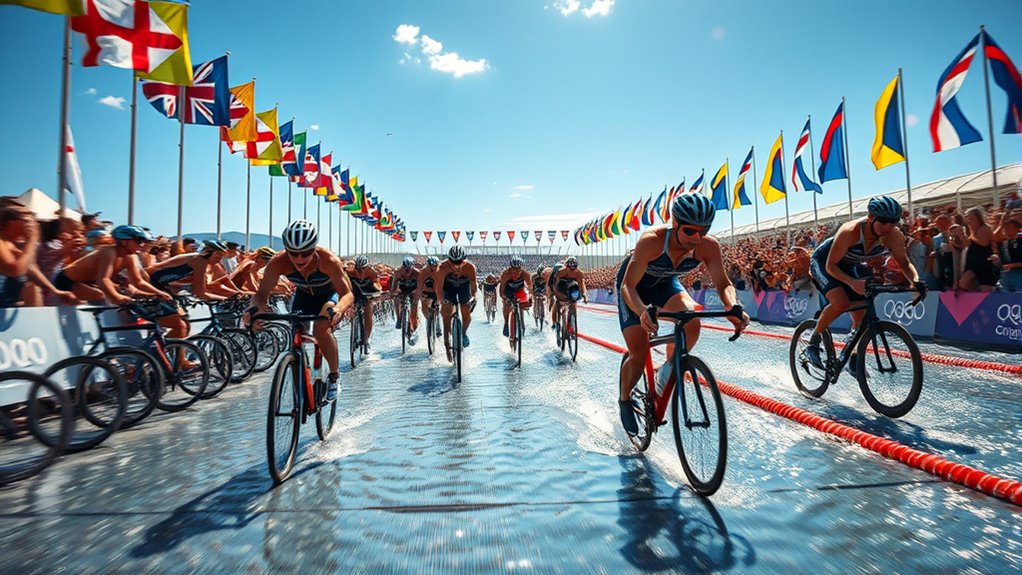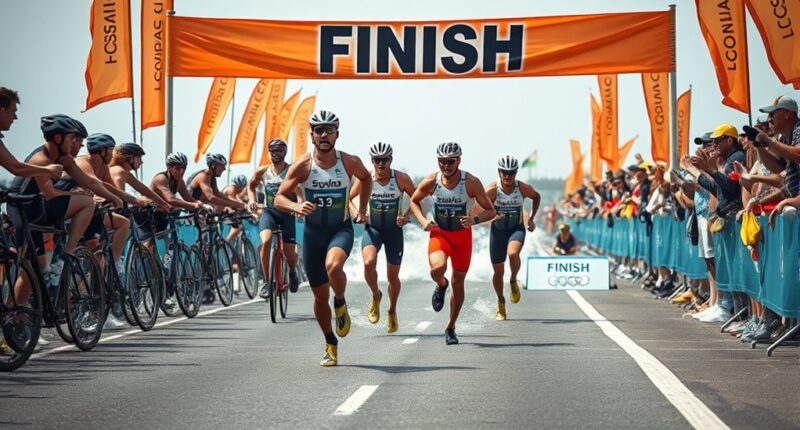Olympic distance events, also known as the standard triathlon, have grown in popularity and competitiveness over time. This demanding race combines swimming, cycling, and running, requiring athletes to develop a well-rounded approach to training, nutrition, and strategy. The sport’s history reflects ongoing development and increased participation, making it more challenging and exciting. To discover how these events have evolved and shaped today’s competitions, keep exploring their rich and dynamic past.
Key Takeaways
- The Olympic triathlon was introduced in 2000, combining swimming, cycling, and running over a set distance.
- The standard Olympic distance is 1.5 km swim, 40 km bike, and 10 km run, established to test versatile endurance.
- The sport has evolved with increased global participation and competitiveness since its Olympic debut.
- Advances in training, nutrition, and technology have enhanced athlete performance over time.
- The event’s popularity continues to grow, reflecting its development into a major international sporting discipline.

Olympic distance events are a popular and challenging format in triathlon competitions, combining swimming, cycling, and running into a single race. This race demands a well-rounded approach, where your training techniques become essential to optimize performance across all three disciplines. To excel, you need a strategic plan that balances endurance, speed, and recovery. You’ll want to incorporate interval training to boost your speed and build stamina, as well as brick workouts that simulate the transition from cycling to running. These training techniques help you adapt to the race’s unique demands, guaranteeing you conserve energy and maintain a steady pace throughout. Equally important is athlete nutrition, which plays a pivotal role in training and race day performance. Proper fueling before, during, and after workouts can markedly impact your endurance and recovery. For instance, consuming carbohydrate-rich foods and electrolyte drinks during training sessions helps replenish glycogen stores and maintain hydration, preventing fatigue and cramping. On race day, a tailored nutrition plan guarantees you have sustained energy, avoiding digestion issues or energy dips that can derail your efforts. Additionally, understanding the history of Olympic distance events**** shows how the sport has evolved to become more competitive and inclusive over time.
Frequently Asked Questions
How Have Olympic Distance Events Evolved Over the Decades?
Over the decades, Olympic distance events have evolved through sprint race development and race format changes, making competitions more exciting and accessible. You’ve seen shorter, faster races introduced alongside traditional formats, encouraging more dynamic strategies. These changes have streamlined race formats, improved spectator engagement, and increased athlete participation. As a result, Olympic distance events now showcase a perfect blend of endurance and speed, reflecting ongoing innovation in the sport.
Which Countries Have Historically Dominated Olympic Distance Events?
Like a steady drumbeat in the race of history, the USA and Australia have symbolized relentless athlete dominance in Olympic distance events. Their medal tallies reflect a commitment to excellence and innovation. These nations have consistently set the pace, inspiring others to chase their legacy. You’ll notice their athletes’ tenacity and skill, making them the enduring symbols of success in these demanding competitions.
What Are the Training Strategies for Olympic Distance Athletes?
You should develop thorough training plans that balance endurance, speed, and recovery, focusing on consistent, structured workouts. Incorporate varied sessions like interval training, long rides, and brick workouts to build stamina. Nutrition strategies are equally essential; prioritize balanced meals rich in carbs, protein, and healthy fats, and stay hydrated. Regularly adjust your training and nutrition to prevent burnout and optimize performance, ensuring you’re prepared for race day.
How Do Olympic Distance Events Compare to Other Triathlon Distances?
Imagine you’re racing an Olympic distance triathlon, where the race pace demands a balance of speed and endurance. Compared to Ironman events, the Olympic race has a shorter, more intense focus, often on a more complex course with sharp turns and technical sections. While Ironman emphasizes sustained effort over hours, Olympic triathlons challenge you with a faster pace, requiring quick shifts and adaptability to course complexity.
What Technological Advancements Have Impacted Olympic Distance Racing?
You see that technological advancements like wearable technology have considerably impacted Olympic distance racing. These devices help you monitor heart rate, pace, and power, optimizing your performance. Race timing systems provide accurate splits and real-time updates, allowing you to strategize better during the event. Together, these innovations give you detailed insights and precise data, helping you train smarter, race more effectively, and improve your overall results in Olympic-distance triathlons.
Conclusion
As you reflect on the history of Olympic distance events, it’s interesting how the very distances that once defined the games continue to inspire athletes today. Coincidentally, the evolution of these events mirrors broader changes in sport and society, reminding you that progress often comes from unexpected places. So, as you watch future competitions, remember that these distances carry stories of innovation, perseverance, and surprising connections—just like your own journey through sports and life.









